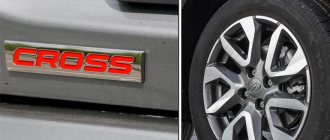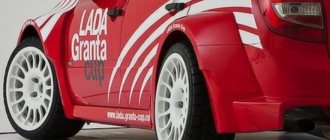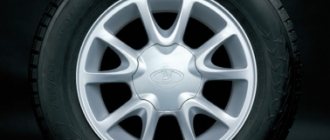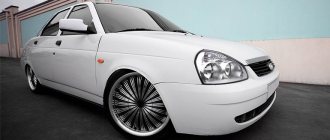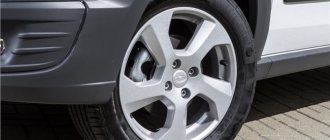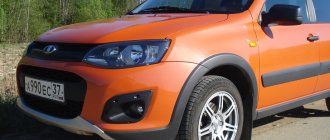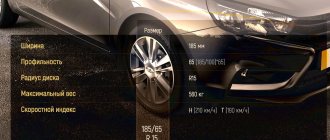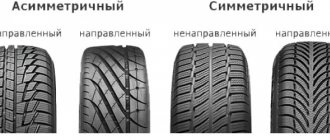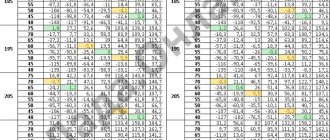Lada Granta is a budget mass car produced by Volzhsky Automobile.
This car has gained great popularity among citizens of Russia and the CIS countries. In view of its demand, the issue of replacing winter tires on Grant is relevant.
The safety of all road users, as well as the comfort of the driver and passengers while driving, depends on well-chosen winter tires.
This article will discuss the features and main characteristics of winter tires for the Lada Granta, and describe the rules for choosing winter tires for the Granta liftback and its other modifications.
Tires on Grant
Basic tire sizes
In principle, to find out what size tires can be installed on a Lada Granta, just look at the passport or at the plate on the inside of the car door.
Nevertheless, we present to your attention a list of parameters that the manufacturer declares using the example of modifications for the 2022 release:
| Modification | Basic size | Replacement options |
| 2190 Sedan/1.6 16V | R14 175/65 | R14 185/60R15 195/50 and 185/55 |
| 2190 Sedan/1.6 8V | R14 175/65 | No options |
| 2190 Sedan/1.6 16V Sport | R15 185/55 | R15 195/50R16 195/50 |
| 2191 Liftback/1.6 16V | R14 175/65 | R14 185/60R15 185/55 |
| 2191 Liftback/1.6 8V | R14 175/65 | R14 185/60R15 185/55 |
Winter tires for Granta: features
When choosing winter tires for a Lada Granta car, you need to know exactly what modification of this car the tires are selected for. The first generation Lada Granta began production in May 2011 as a sedan in several trim levels. At the same time, Lada Granta Sport was introduced. In May 2015, production of the Lada Granta Liftback began.
The production of the first generation "Grants" ended in 2022. In 2019, mass production of the second generation Lada Granta began in two bodies: a sedan and a liftback, in several trim levels.
The in-plant designation of the Lada Granta sedan car is VAZ 2190, the Lada Granda liftback is VAZ 2191.
Characteristics
Any car tire has a number of characteristics that must be taken into account in order to choose the right tire for your car.
The first most important characteristic of rubber is size. Tire size parameters using the 175/65 R14 marking as an example:
- 175 is the width of the tire, measured in millimeters.
- 65 is the profile height, measured as a percentage of the tire width.
- R - indicates that the tire is radial (from the English word radial), but certainly not that the radius designation follows, as many people think. Wheels have no radius, only diameter. The radius of a tire is its type of construction. There is also a bias tire type.
- 14 is the tire diameter in inches. To convert this figure into the usual centimeters, you need to multiply the inch value by 2.54.
Tire size
The second important characteristic of any tire is the maximum weight and speed index. It is most often recommended to install 82 H tires on Grant cars. This marking indicates that this tire can withstand loads of up to 475 kg and operates effectively at speeds of up to 210 km/h.
Note!
The maximum load parameter is indicated for one tire. Therefore, for a set of 4 tires, the maximum load in this case will be 1 t 900 kg. Considering that the average total weight of the Grant is 1.5 tons, the load on the tire is calculated with a good margin.
Next, you need to pay attention to the presence of thorns. Many versions of winter tires are produced without studs at all. Some have sparse thorns. Each manufacturer strives to come up with a new, improved type of studs. They differ in shape, size and material from which they are made. Their main purpose is to pierce the ice for better starting and braking on icy surfaces.
Additional Information!
In many countries, including Russia, there is a legal restriction on having too many studs on a tire. This is due to the fact that the spikes damage the asphalt surface.
The next important factor is the depth of the tread pattern and the pattern itself. The tread determines the quality of wheel grip on the road surface. The more technologically advanced the pattern on the rubber is, the better the tires will have noise, drainage and reliability characteristics.
You may be interested in this About crossover tires
In addition, there are many other characteristics. In general, the better the quality of the tire, the more reliable and stable ride it will provide.
Low-quality cheap tires can also wear out extremely quickly and lose studs, so such savings are not always appropriate.
Tire pressure
We found out which tires are suitable for the Lada Granta - now we’ll figure out the pressure. A lot depends on it during the operation of tires, the purchase of which is one of the sources of expense for any car owner. The pressure must be constantly monitored to ensure that the tires do not wear out too quickly.
Premature wear occurs when there is insufficient pressure, but over-pumping is also fraught with consequences.
- If the pressure is regularly lowered by 0.5 Atm less than the norm for 14 radius of 1.9 Atm in the front, and 2.0 Atm in the rear, the tires will last 4 times less - plus fuel consumption increases.
- With an even greater lack of pressure, the car may lose control and the braking distance increases.
- If you drive for a long time on half-flat tires and then inflate them, the tire may simply explode.
Therefore, you need to have a pressure gauge on hand, take measurements from time to time (especially in winter), and if you need to pump up the wheels. The front and rear pair of tires should have the same pressure.
Specific indicators depend on the wheel size. Take, for example, the 195/50 profile, which is one of the replacement options for the LADA Sedan Sport. If this is a radius of 15, then the optimal pressure is 2.3 Atm, and at radius 16 you need to pump 2.4 Atm.
Selection of tires by model
Knowing the size of the “shoes”, all that remains is to choose the style. Any car should have two sets of tires: winter and summer. Winter tires are installed without waiting for frost, but when the thermometer regularly drops below +5 degrees.
To save on the purchase of winter tires, some drivers make the mistaken decision to drive all-season tires. Therefore, we will make a small digression and explain why this should not be done.
When and what tires are needed for a car?
Let’s say right away that there are no tires that behave stably in any conditions. Why then is the tire called all-season? Because of the tread, which must have a deep relief and grooves through which water, dirt, and slush can easily pass.
All-season tires are tires that are comfortable to drive in the off-season, when the air temperature varies from +7 to -10 degrees. It is often marked M+S (mud/snow), which confuses many.
But in fact, an all-season tire is a summer tire and is not suitable for year-round driving, even in the southern regions of the country.
- All mud tires, and all winter tires, have an all-season tread. The only difference is in the rubber composition, which is designed for positive or negative wheel operation. On a winter tire, for better grip on icy roads, many thread-like sipes are made, which distinguishes it from all-season tires.
- Studless winter tires are popularly called Velcro. On such tires, the car feels great in icy conditions, but when the temperature outside is consistently positive (above +6-7 degrees), it must be changed to summer shoes.
- Winter tires are much softer, so if you try to drive them in the summer, they will wear out quickly. Studded tires are better suited for driving on snow, so when in winter you have to drive not on cleared asphalt, but on a country road, it is better to give preference to studded tires.
- All year round, all-season vehicles are driven mainly by trucks and buses, on which changing wheels is a labor-intensive process, and besides, there are usually more than four of them. True, in severe frosts and snowfalls they have a hard time riding on such tires.
And another important factor is for those who spend a lot of time driving. A tire for winter use is much softer than a summer one, but it is also noisy when driving, especially the studded one.
The summer one, and it is also an all-season one, in severe frosts “steals” and just rattles. And this is not to mention the fact that you will not so much ride on the ice as perform figure skating.
All-season for regions with warm winters
Let’s be honest, it’s not just southerners who choose such tires.
Year-round use wears out a set of tires faster, but there is a downside. Owners of all-season tires do not experience any problems with autumn-spring tire fitting.
However, compared to users with two sets of disks, this advantage does not count. Doubts about the driving characteristics of all-season tires at different temperatures are quite expected and obvious. The only thing these tires cannot be denied is practicality. Our preferences in this segment are as follows:
